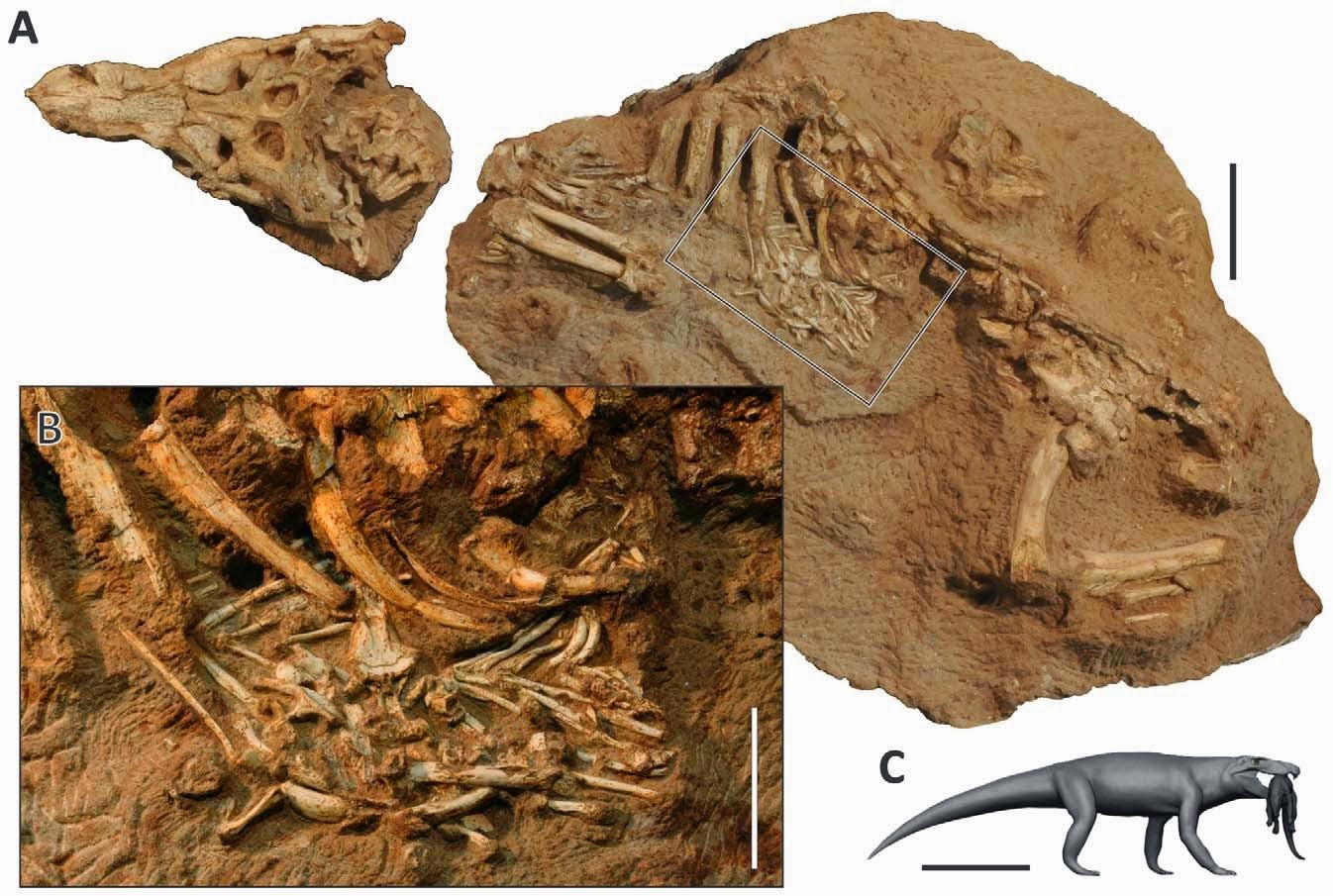The Mekosuchine Crocodile Mekosuchuswhitehunterensis
was described from Late Oligocene deposits exposed at the White Hunter Site in
the Riversleigh World Heritage Area innorthwestern Queensland. It is
interpreted to have been largely terrestrial, and to have been a dwarf species
reaching maturity at little over a meter in length. However dwarfism is hard to
diagnose in fossil Crocodilian species, as the animals grow throughout their
entire lives, only slowing their growth rate when they reach maturity, and
because small Crocodillian species tend to be essentially similar to juveniles
of larger species.
In a forthcoming paper in the journal Acta Palaeontologica Polonica,
available online from 16 January 2015, Michael Stein, Michael Archer and Suzanne Hand of the School of Biological, Earth and Environmental Sciences at the
University of New South Wales describe additional material assigned to Mekosuchus whitehunterensis from the Early Miocene Price is Right Site and Late Oligocene Hiatus
and LSO sites, also in the Riversleigh World Heritage Area.
The original material from the White Hunter Site comprised entirely
cranial material. The new material from the Price is Right Site comprises a
left maxilla and dentary (upper and lower jaw bones) which appear to belong to
the same species, as well as a series of five associated cervical vertebrae.
The material from the Hiatus Site comprises two vertebrae which appear to be
from the same species as those at the Price is Right Site, while the LSO site
material comprises a single vertebra, again apparently of the same species.
Rostra of Mekosuchine Crocodile Mekosuchus whitehunterensis.(A) Left maxilla in buccal (A1)
and ventral (A2) views. (B) Left dentary in lingual (B1),
dorsal (B2), and buccal (B3) views. Scale bars 5 cm.
Stein et al. (2015).
Vertebrae are much more useful in assessing the maturity of a
Crocodilian than cranial material, as the neurocentral suture closes (mineralizes)
in mature individuals. The new vertebrae appear to come from a mature
individual, and have a mean anterioposterior length (front-to-back length,
thickness) of 19.3 mm. The most complete known skull of Mekosuchus whitehunterensis is about 10 cm in length, which combined
with the proportions of the vertebrae suggest a mature individual measuring
about 60 cm, considerably smaller than the smallest modern Crocodilians, Osteolaminus and Paleosuchus, both of which typically exceed a meter in length at
maturity.
Vertebrae of Mekosuchine Crocodile Mekosuchus whitehunterensisin left (A1–H1)
and right (A2–H2) views. (A) Axis vertebra. (B) Third
cervical vertebra. (C) Fourth cervical vertebra. (D) Sixth cervical vertebra. (E)
Ninth cervical vertebra. (F) Third thoracic vertebra. (G) Third cervical
vertebra. (H) Eighth cervical vertebra. Arrows indicate extent of the
neurocentral suture. Scale bars 2 cm. Stein et
al. (2015).
The cervical vertebrae show significantly enlarged muscle attachments,
suggesting that the living animal had powerful neck muscles. This has
implications for the feeding strategy of the living animal. Modern Crocodiles
remove meat from prey animals in two ways. Firstly they body role, taking a
firm grip of their prey they rotate their entire bodies in order to tear
digestible pieces from the prey. However this strategy is seldom employed by
small Crocodilians, which lack the mass use this strategy effectively. It is
also a feeding method best suited to an aquatic environment, where the water
cushions the body from any damage, and could be rather more risky in a
terrestrial environment (where Mekosuchus whitehunterensisis
thought to have fed) as friction with the ground could potentially lead to
damage to the body or limbs. Secondly Crocodiles can remove meat from a prey
animal by vigorously shaking their heads in a manner similar to a Dog. This is
a strategy of limited usefulness in an aquatic environment, where the prey is
likely to simply move with the head, but can be very effective on dry land,
where the prey is held down to some extent by gravity and experiences friction
with the ground. The enlarged neck muscles of Mekosuchus whitehunterensis would seem suitable for such a feeding
method, supporting the idea that it hunted or scavenged away from the water.
See also…
 A Baurusuchid Crocodyliforme with preserved stomach contents from the Late Cretaceous of Brazil. The Adamantina Formation from the Late Cretaceous of southern Brazil
produces a wide variety of Crocodyliformes, including semi-aquatic...
A Baurusuchid Crocodyliforme with preserved stomach contents from the Late Cretaceous of Brazil. The Adamantina Formation from the Late Cretaceous of southern Brazil
produces a wide variety of Crocodyliformes, including semi-aquatic...
The Tethysuchians were a group of largely marine Crocodyliforms that
are reasonably well known from the Middle and Late Cretaceous, with one group,
the Dyrosauridae surviving the End Cretaceous extinction...
The Rosso Ammonitico Veronese is a red nodular limestone found on
the Trento Plateau in northern Italy,
and Middle to Late Jurassic in age. It is noted for its numerous Ammonite
fossils, but also produces occasional Marine Reptiles, notably Thalattosuchian Crocodylomorphs
and Plesiosaurians. The earliest recorded discovery of such a Reptile is a
Crocodylian...
Follow Sciency Thoughts on Facebook.




